The business fiscal year can end with an unexpected surprise — a little extra money that wasn’t spent from your company’s budget. That makes it the optimum time to upgrade your Mac equipment to something newer and faster. In today’s post, we’ll provide some ideas on our opinion of the best Mac gear for those who work from home or a remote office.
Home Office
For those who work from home, there’s a perfect solution if you don’t need a computer that can travel with you: the 27-inch iMac or iMac Pro. The choice between these two models is dependent on what work you perform from your home office.
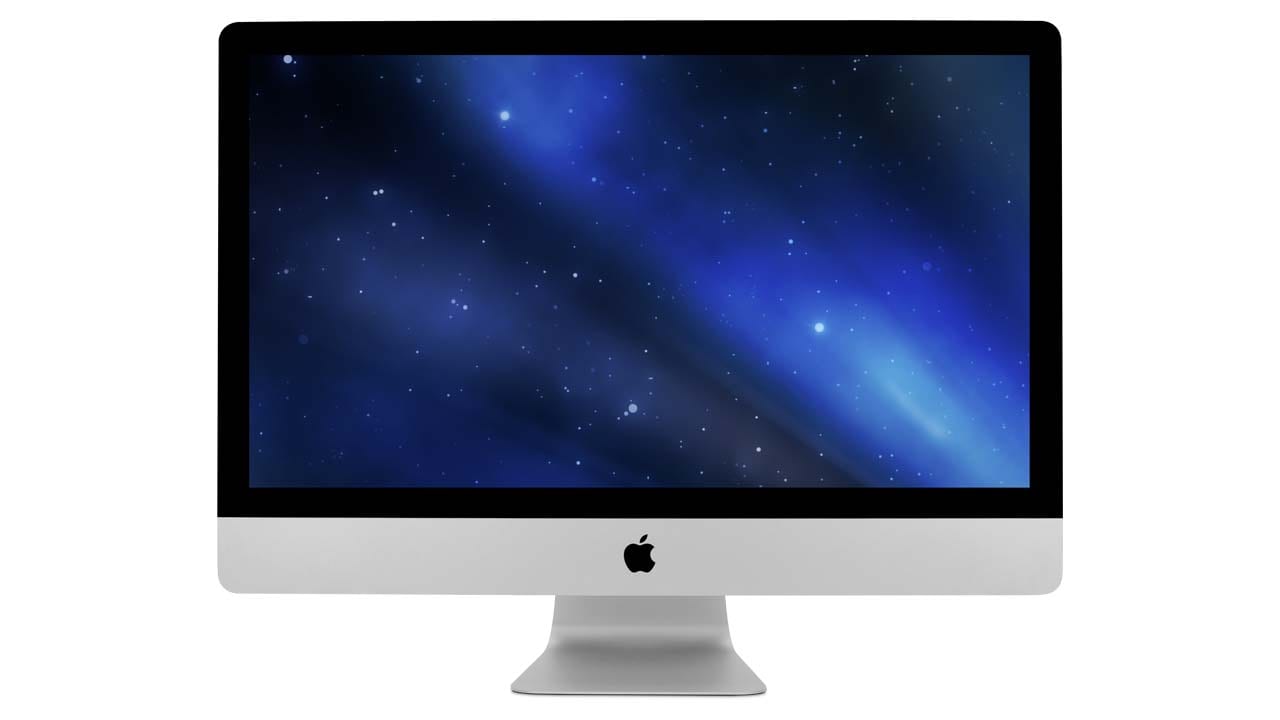
iMac: I’m a huge iMac fan, having used one since I left corporate America in 2004 and started my own company. The first model iMac I owned was a 20-inch iMac G5 that looked similar to the 27-inch 5K Retina behemoth that I now use. What I love about the 27-inch iMac is…well, everything. It can be outfitted with a fast processor and lots of storage at a fairly reasonable price, it’s silent, it has a huge and stunning display, and it can actually be upgraded with additional RAM later on. I honestly think that this iMac — or a mid-2018 model like that now available from Apple — is the best desktop computer on the market.
When I purchased my 27-inch iMac in late 2015, I ordered it with “only” 16GB of RAM, knowing full well that if my memory requirements increased in future years, I would be able to point my favorite web browser to OWC and purchase RAM upgrades that I could install myself for less than what Apple would charge to have the same RAM installed as a configure-to-order option.
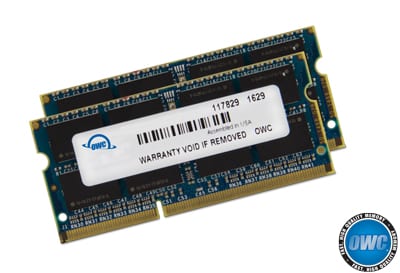
Those upgrades are installed by opening a small door on the back of the 27-inch Retina 5K iMac, possibly removing the old DDR3 RAM, and installing the new SO-DIMMs. My factory RAM consisted of two 8GB SO-DIMMs, so purchasing two more 8GB sticks for a total of 16GB additional RAM and 32GB total RAM would cost me only $109.97 (as of publish date). Not bad for doubling the memory of this computer. My second option is to order two 16GB SO-DIMMs (32GB) at $329.99 to take the total RAM to 48GB.
Why do I need more RAM? Well, the three-year-old iMac is still working just fine and is fast enough for all of the tasks I’m performing. However, I’m getting into more video editing and have a need to run virtual machines under Parallels Desktop, so I’m in a situation where having more RAM will keep this computer at peak performance.
Enough about RAM. The other big need I have with my existing iMac is to keep it backed up. I do a dual desktop backup, using a 4.0TB RAID drive with Thunderbolt and USB 3 for a bootable nightly backup, as well as a 2TB OWC Mercury Elite Pro mini for doing continuous Time Machine backups.
If my video editing storage needs continue to grow, I plan to purchase an OWC ThunderBay 4 RAID 5 Edition outfitted with 16TB of RAID 5 storage. Will I ever give up this iMac? It depends…but if I do, my next desktop Mac may be an iMac Pro.
iMac Pro: The iMac Pro is currently the speed demon of the Apple line, and for those who work from home who have needs to render images, edit video (up to 8K resolution), create real-time audio effects, or compile huge apps, it’s the machine of choice. That might change when the new Mac Pro allegedly ships in 2019, but for a computer with an excellent 5K Retina display, up to an 18-core Xeon processor or 4.5GHz Turbo Boost speeds, Radeon Pro Vega graphics, and up to 128GB of RAM (sadly not user-configurable after purchase), the current iMac Pro is probably the best power machine to buy.

With this much power, you’re going to need copious amounts of fast external storage. The iMac Pro has four Thunderbolt 3 ports, and OWC has a lot of options to give you the pro edge. First, the Thunderbolt 3 Dock comes in Space Gray to match your iMac Pro and is loaded with expansion: SD card and micro-SD card ports that you don’t need to reach around that 27-inch display to use, five USB 3.1 Gen 1 ports, analog audio in/out and S/PDIF ports, Gigabit Ethernet, a USB 3.1 Gen 2 (USB-C) port, a pair of Thunderbolt 3 ports, and even a Mini DisplayPort. If that doesn’t give you the expansion you need to run an app development shop or video editing studio, I don’t know what will.
Oh, we may have neglected looking at the best external storage for your iMac Pro. The OWC ThunderBay 6 RAID offers pretty incredible performance (up to 1500 MB/s) and capacity (up to 72TB).
Remote Work
Remote workers are on the move. One day you might be working from your home office, the next traveling by air or driving to a branch office. It doesn’t make a lot of sense for someone who is constantly on the move to have a desktop Mac, so Apple’s laptop line from MacBook Air to MacBook Pro is a great portable solution.

MacBook Air: Although the recent update to the MacBook Air brought it up to speed with some of the other MacBooks, it’s still the “lightweight” of the family both in terms of power and physical attributes. The MacBook Air is limited to a 1.6GHz dual-core 8th-generation Intel Core i5 processor and 16GB of RAM, although it can be outfitted with up to 1.5TB of storage. As a result, it’s the perfect machine for anyone who isn’t going to be using a laptop for more than email, web browsing, and general productivity apps. Even the “old” 1.8GHz dual-core model (5th generation Intel Core i5 processor) non-Retina-display model is adequate for this type of work, and at $999 it’s Apple least expensive laptop.
Being on the road is no excuse for not keeping your device backed up, and the OWC Mercury On-The-Go Pro has USB 3.1 Gen 1 for speed, fast solid state storage up to 1TB or hard drive storage capacities up to 2TB.
MacBook: Apple has made the “which laptop do I buy?” decision much more difficult with the addition of the new MacBook Air, but for someone who needs a combination of ultra-light portability and a bit more power, the MacBook is an excellent choice. The MacBook features a Retina display and a dual-core Intel Core i7 processor with Turbo Boost up to 3.6GHz. Oddly enough, though, storage on the MacBook is limited to 512GB…
Once again, the OWC Mercury On-The-Go Pro is an excellent option for a portable backup device.
MacBook Pro: For the person who wants the best of both worlds — meaning lots of computing power but the ability to work anywhere — there’s nothing quite like the 15-inch MacBook Pro. With four Thunderbolt 3 ports for expansion and the addition of an OWC Thunderbolt 3 Dock to top that off, the road warrior can have a decently-sized Retina display for work away from the home office as well as multiple display options when back at home.
What kind of display options? The 15-inch MacBook Pro can drive two 5K (5120 by 2880 pixel resolution) displays or four 4K (4096 by 2304 pixels) at the same time while displaying full native resolution on the built-in display.
Neither storage nor memory are user-upgradeable, but the device can be configured-to-order with up to 4TB of internal SSD storage and up to 32GB of RAM. Those who need portability and graphics power (think of a freelance film editor who needs to do dailies from a work trailer), configuring the MacBook Pro with a Radeon Pro Vega 16 or Radeon Pro Vega 20 with 4GB of HBM2 memory makes good use of the eighth-generation Intel 6-core or quad-core processors (top of the line being a 2.6-GHz 6-core Intel Core i7 with Turbo Boost up to 4.3 GHz).
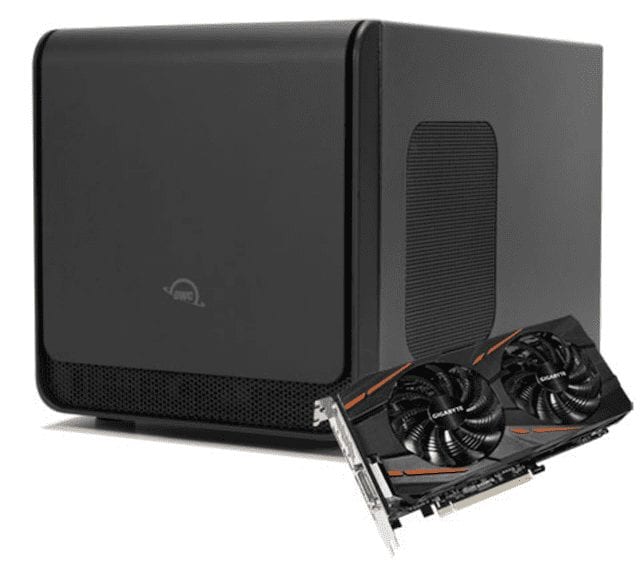
Need even more graphics power? External graphics processing units (eGPUs) can give the mobile user the graphics performance of a high-end desktop workstation without sacrificing the portability of the laptop. Set up those 4 big monitors when you’re in your field office and hook up an OWC Mercury Helios FX eGPU with a Radeon RX580 GPU card loaded with power and your MacBook Pro can handle almost any rendering or video editing task.
Sure, it may not be an iMac Pro…but do you really want to carry an iMac Pro on the road with you?
The Bottom Line
Mac fans have probably never had a better time to make a decision on how to equip their home offices or gear up for work on the road. From the hard-working and reasonably-priced 27-inch iMac to a fully-loaded MacBook Pro, Apple has a lineup of devices that do the job for just about any person who works from home or travels a lot. Whatever your decision ends up being, OWC has a wide variety of storage, expansion and memory options available to give your new Mac the right customization to make it work for you.
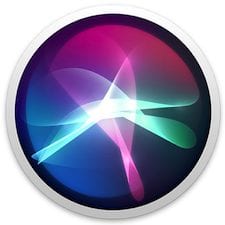
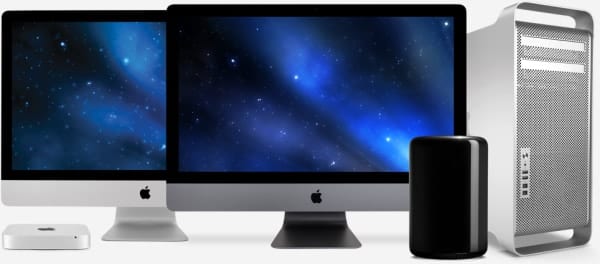








What mid-2018 iMac do you mean? As far as I (and EveryMac.com) know, the latest iMac is from last year.